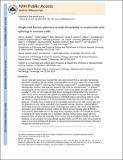Single-cell transcriptomics reveals bimodality in expression and splicing in immune cells
Author(s)
Shalek, Alex K.; Satija, Rahul; Adiconis, Xian; Gertner, Rona S.; Gaublomme, Jellert T.; Raychowdhury, Raktima; Schwartz, Schraga; Yosef, Nir; Malboeuf, Christine; Trombetta, John J.; Gennert, David; Gnirke, Andreas; Goren, Alon; Hacohen, Nir; Levin, Joshua Z.; Park, Hongkun; Regev, Aviv; Lu, Diana, Ph. D. Massachusetts Institute of Technology; ... Show more Show less
DownloadRegev_Single-cell.pdf (1.694Mb)
PUBLISHER_POLICY
Publisher Policy
Article is made available in accordance with the publisher's policy and may be subject to US copyright law. Please refer to the publisher's site for terms of use.
Terms of use
Metadata
Show full item recordAbstract
Recent molecular studies have shown that, even when derived from a seemingly homogenous population, individual cells can exhibit substantial differences in gene expression, protein levels and phenotypic output1, 2, 3, 4, 5, with important functional consequences4, 5. Existing studies of cellular heterogeneity, however, have typically measured only a few pre-selected RNAs1, 2 or proteins5, 6 simultaneously, because genomic profiling methods3 could not be applied to single cells until very recently7, 8, 9, 10. Here we use single-cell RNA sequencing to investigate heterogeneity in the response of mouse bone-marrow-derived dendritic cells (BMDCs) to lipopolysaccharide. We find extensive, and previously unobserved, bimodal variation in messenger RNA abundance and splicing patterns, which we validate by RNA-fluorescence in situ hybridization for select transcripts. In particular, hundreds of key immune genes are bimodally expressed across cells, surprisingly even for genes that are very highly expressed at the population average. Moreover, splicing patterns demonstrate previously unobserved levels of heterogeneity between cells. Some of the observed bimodality can be attributed to closely related, yet distinct, known maturity states of BMDCs; other portions reflect differences in the usage of key regulatory circuits. For example, we identify a module of 137 highly variable, yet co-regulated, antiviral response genes. Using cells from knockout mice, we show that variability in this module may be propagated through an interferon feedback circuit, involving the transcriptional regulators Stat2 and Irf7. Our study demonstrates the power and promise of single-cell genomics in uncovering functional diversity between cells and in deciphering cell states and circuits.
Date issued
2013-05Department
Massachusetts Institute of Technology. Department of BiologyJournal
Nature
Publisher
Nature Publishing Group
Citation
Shalek, Alex K., Rahul Satija, Xian Adiconis, Rona S. Gertner, Jellert T. Gaublomme, Raktima Raychowdhury, Schraga Schwartz, et al. “Single-cell transcriptomics reveals bimodality in expression and splicing in immune cells.” Nature 498, no. 7453 (May 19, 2013): 236-240.
Version: Author's final manuscript
ISSN
0028-0836
1476-4687